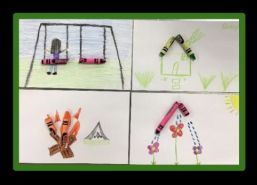
Who knew something as simple as crayons could teach some important life lessons? The Crayon Life Lessons teaches students a variety of lessons about acceptance, diversity and uniqueness that can be used in all settings from home, to school, to work in a unique way. I used it in my child development classes, but it could be used in any class as an enrichment activity!
Set for Day One
- How are people like crayons? Brainstorm as many as you can before the timer runs out. Be prepared to share. As students share, create a master list. Answers may include: some are tall, short, different colors, etc.
- Give students the opportunity to select one crayon color of their choice and give them a blank piece of paper.
Materials
- Crayons
- Blank Paper & Large Index Cards
- “The Crayon Box that Talked” Book (affiliate link) or YouTube Video Version
- Glue
Activities
- Ask students to draw a picture on their blank paper using only that single crayon color.
- Give students another piece of blank paper and give them access to the entire box of crayons. Ask them to draw another picture on their paper using as many colors from the box as desired.
- Ask students to share their creations with their neighbor and then the whole class before asking them which creation they would prefer to display and why. The majority of my students prefered to share the colorful over the single color drawing.
- I asked students what the KEY takeaway of this activity was and we discussed their responses which basically was that more color was exciting, less boring and more creative.
- Read or show the video of “The Crayon Box that Talked” to students and ask them to generate some life lessons they learned from the story. Some included that we need to be nice to each other (no put downs), accept and include each other because we are all unique and have something special to offer.
- Students then create a T-Chart. On one side, brainstorm differences that are used to separate, exclude or even bully children/people. On the other side, brainstorm reasons why it’s important to accept children/people who are different. Share & discuss.
- As an exit slip, students write their response to this prompt in a Google Question or you could use post-it notes: What can we learn from a box of crayons?
Set for Day 2
- Describe a new box of crayons. Share as a class. Why do we like them so much? What happens to crayons over time, especially if they are used a lot? (points become dull, size changes, paper comes off, they break, etc.) What happens then? What do you do? (Do you avoid them, take them out of the box, discard them?) Suppose the crayon became life-like…what might the effects of those actions be emotionally and/or socially? (lower self-esteem, confidence, feel isolated/excluded, withdraw, feel useless, etc.)
- Ask students how they might remedy that. Examples may include: transform yourself into something entirely new/different such as melting together to create a new crayon/color, you might stay true to yourself and show/share your best qualities, or you might make the best of the situation by thinking beyond the crayon…turn a negative into a positive.
Activities
- Broken Crayon Activity: Give each student an index card and a crayon. Ask them to break it. Share that sometimes we contribute to the breaking of our own self by negative talk & put downs.
- Ask students to think creatively and transform their “broken crayon” into a new creation. Show examples via this gallery. Once they have an idea, glue the broken crayon onto the index card and create their visual using as many colors as desired. Share & hang to display!
- 3-2-1 Exit Slip: Share 3 lessons you learned from crayons, Share 2 index card creations from the class you thought were very creative, and Find and share an inspirational quote, including author that sums up the KEY takeaway from the broken crayon activity. Share quotes in the next class and add them to the index card creations if desired.
Attachments
- 3-2-1 Exit Slip (PDF)

